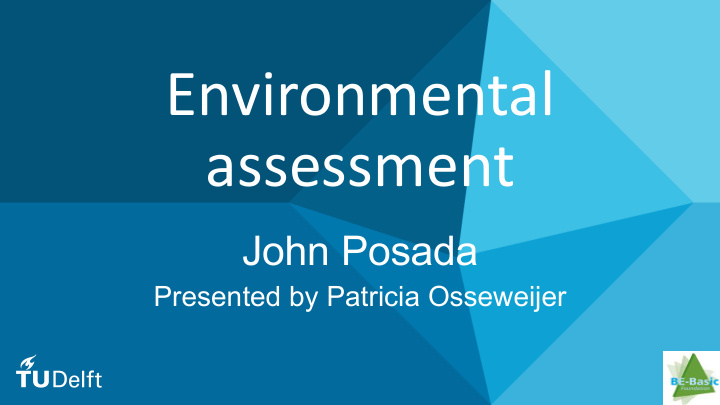



Environmental assessment John Posada Presented by Patricia Osseweijer 1
Environmental impacts assessment Some methodologies available for detailed assessment of environmental impacts of chemical processes: 1. Life cycle assessment (LCA) 2. Waste reduction ( WAR ) algorithm 3. Minimum environmental impact ( MEI ) methodology 4. Atmospheric hazards index ( AHI ) 5. Environmental fate and risk assessment tool ( EFRAT ) 6. Thermodynamic analysis method
The four steps of an LCA Life cycle assessment framework Interpretation Goal & Scope Direct applications Definition • Consistency check • Product/process development and • Completeness check improvement Inventory • Contribution/ • Strategic planning Dominance analysis Analysis • Public policy making • Sensitivity, Scenario, Uncertainty analysis • Others… Impact • Conclusions, Limitations Assessment & Recommendations International Organization of Standardization, ISO-14040 : Environmental Management – Life Cycle Assessment – Principles and Framework, ISO, Geneva, Switzerland (2006). ISO-14044 : Environmental Management – Life Cycle Assessment – Requirements and Guidelines, ISO, Geneva, Switzerland (2006).
LCA-Step 1. Goal and Scope definition, LCA-Step 1. Goal and Scope definition, bio-based PDO case-study. bio-based PDO case-study. Cradle-to-grave Cradle-to-gate Cradle-to-gate Air Recycle ? Energy Water Materials Land Waste Products Feedstock Raw materials Use Management Research Questions : “What are the environmental impacts of the bio-based PDO production process? ... And how do they compare to petrochemical counterpart and other LCA studies?” System boundaries : Cradle-to-factory gate
LCA-Step 1. Goal and Scope definition, bio-based PDO case-study. Cradle-to-gate Emissions to Air, Water, Land Energy PDO Sugar Main product Materials co-products Material & Energy Sugar cane Sugar cane PDO Production Milling Production Raw material : Sugar from Brazilian sugar cane Functional Unit : 1 kg PDO
LCA-Step 2. Life cycle inventory (LCI), bio-based PDO case-study. Cradle-to-gate Emissions to Air, Water, Land Energy PDO Sugar Main product Materials co-products Material & Energy Sugar cane Sugar cane PDO Production Milling Production Foreground Background Processes Processes
LCA-Step 2. Life cycle inventory Sugar Production (Background processes) NaOH H 2 SO 4 Lime Fertilizers Products Unit Raw Pesticides cane Sugar Sugar 40 % Sugar cane Sugar cane Lime/seeds production milling Hydrous ethanol 39 % Fuels Others Anhydrous ethanol 21 % Surplus Filter cake bagasse Bagasse Cane juice Hydrous Other products Unit ethanol Cogeneration Water Ethanol Production Electricity surplus 10.7 kWh/t cane Anhydrous system ethanol Bagasse sold/ Steam & 3.3 % total produced electricity Electricity Data from: Seabra et al. (2011). Biofuels, Bioprod. to grid Bioref . 5:519–532
LCA-Step 2. Life cycle inventory PDO Production (Foreground processes) Inventory tables: CO 2 Normalized per functional unit Overall Flows Sugar Components (kg/kg PDO) PDO Ammonia Sugar 3.48 Process water Fermentation water 19.42 Glycerol 0.72 Process water Others Ammonia 0.05 Glycerol 0.07 Sulfuric acid 0.04 Electricity Sodium hydroxide 0.02 Steam Waste water treatment Waste Water 3.26 2.13 Electricity (units/MJ)* Steam 3.96 Cooling water 29.89 * Electricity, units in (MJ/MJ and kg CO 2 eq/MJ)
LCA-Step 3. Life cycle impact assessment (LCIA) 3.1. Definition and classification of impact categories Recommended readings Area of protection Natural Human Natural Environment (endpoints) Health resources Environmental mechanism Climate change Ozone layer Land-use (impact pathway) Impact potentials Eutrophication Acidification Resource depletion (midpoints) Carcinogens Summer smog Ecotoxicity Pressures NO x , Cd, CO 2 , CH 4 , dioxins, energy, coal, silver ore, land use… and other emissions and resource flows (inventory) Figure adapted from: European platform on life cycle assessment (EPLCA)
LCA-Step 3. Impact assessment 3.2. Characterization of category indicator results !: #$%&'$! 'ℎ$ )&*+&%$%' Emissions & Inputs/ Characterization factors Category Indicator Results outputs Inventory GHG NREU NREU GHG Overall flows Components (kg CO 2 eq/kg) (MJ/kg) (MJ/kg PDO) (kg CO 2 eq/PDO) (kg/kg PDO) Sugar 0.72 0.23 3.48 2.51 0.81 Fermentation water 0.02 0.00 19.42 0.34 0.02 = Process water 0.01 0.00 0.72 0.00 0.00 * Ammonia 41.67 2.10 0.05 2.23 0.11 24.25 2.84 Glycerol 0.07 1.76 0.21 Sulfuric acid 2.02 0.12 0.04 0.07 0.00 Sodium hydroxide 21.36 1.10 0.02 0.40 0.02 Waste water treatment 0.32 0.18 1.05 0.59 3.26 Electricity (units/MJ)* 0.42* 0.06* 2.13** 0.90 0.14 Steam 3.95 0.23 5.94 23.47 1.39 0.01 0.00 Cooling water 44.83 0.25 0.01 3.31 32.98 * Electricity, units in (MJ/MJ and kg CO 2 eq/MJ) ** Electricity in (MJ/kg PDO)
LCA-Step 3. Impact assessment (3) 3.2. Characterization of category indicator results !: #$%&'$! 'ℎ$ )&*+&%$%' 3.3. Normalization. Optional k : #$%&'$! 'ℎ$ ,*+-)' )-'$.&/0 3.4. Weighting. Optional 3.5. Grouping. Optional
LCA-Step 4. Interpretation of results Verification of results from several perspectives: • Consistency check • Completeness check • Contribution analysis
LCA-Step 4. Interpretation of results Verification of results from several perspectives: • Consistency check • Completeness check • Contribution analysis • Comparison analysis ?
LCA-Step 4. Interpretation of results Verification of results from several perspectives: • Consistency check • Completeness check • Contribution analysis • Comparison analysis • Sensitivity analysis • Uncertainty analysis • Scenario analysis Characterization factors for EU sugar beets and US corn are directly taken from EcoInvent database (website: http://www.ecoinvent.org/database/).
Integral assessment: standards PPP (People-planet-profit) concept: People Integrating results and weighing of factors Bearable Equitable Sustainable Planet Profit Standards for sustainable production Viable 12 principles developed by the Round Table for Sustainable Biomaterials http://rsb.org/sustainability/rsb-tools-guidelines/
Recommend
More recommend